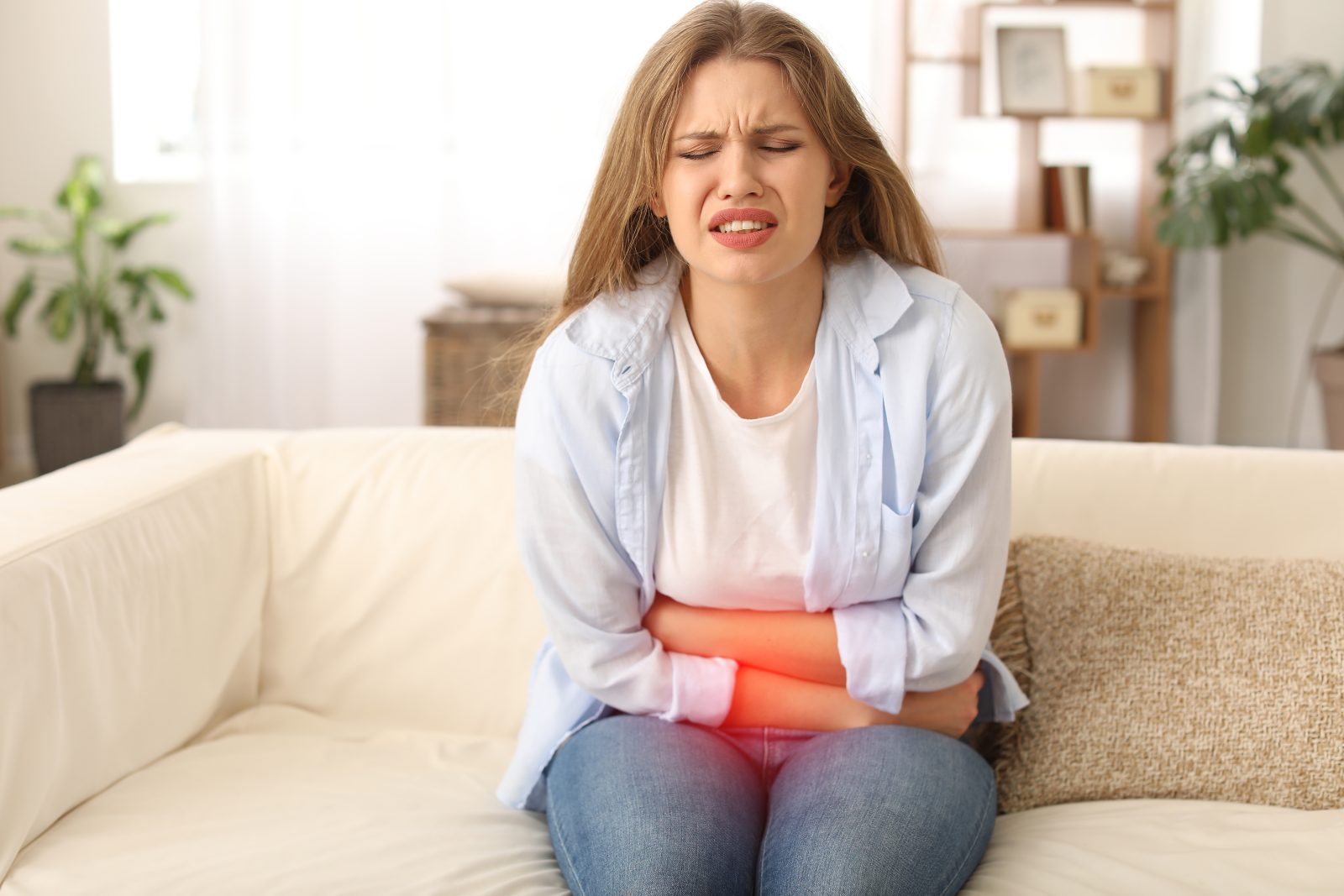Experiencing pelvic pain and cramping without the onset of a menstrual period can be perplexing and concerning. In some cases, it is nothing serious, but in others, it may be a sign of other women’s health issues and it is recommended to seek professional help.
While it is common to associate cramps with menstruation, various other conditions can also cause similar discomfort.
Understanding these potential causes is crucial for appropriate management and treatment.
Common Causes of Cramps Without a Period
- Ovulation
What it is: Mid-cycle ovulation pain, known as “mittelschmerz,” occurs when the ovary releases an egg. This is a normal part of the menstrual cycle and affects many women.
Symptoms: Pain is usually felt on one side of the lower abdomen and lasts from a few minutes to a few hours, but can persist for up to two days. The pain can be sharp and sudden or dull and crampy. The side of the pain depends on which ovary releases the egg.
Diagnosis and Treatment: Generally, no treatment is needed as the pain is harmless and temporary. Over-the-counter pain relievers like ibuprofen or acetaminophen can be used if necessary. Applying a warm compress to the abdomen may also provide relief.
- Inflammatory Bowel Disease (IBD)
What it is: IBD includes conditions such as Crohn’s disease and ulcerative colitis, which involve chronic inflammation of the digestive tract. Crohn’s disease can affect any part of the gastrointestinal tract from mouth to anus, while ulcerative colitis is confined to the colon.
Symptoms: Cramps and pain can range from mild to severe and may be localized to specific areas of the abdomen.
With Crohn’s, pain is often felt in the right lower or middle parts of the abdomen. In ulcerative colitis, cramps typically occur on the lower left side.
Other symptoms include severe changes in bowel movements (diarrhea, constipation), urgent need to defecate, feeling that the bowels aren’t completely empty, blood in stool, weight loss, fever, and fatigue.
Diagnosis and Treatment: Diagnosis typically involves endoscopy, colonoscopy, and imaging tests. Blood tests may reveal anemia or infection.
Treatment includes medications to reduce inflammation and manage symptoms, dietary changes, and sometimes surgery. In severe cases, immune-suppressing drugs or biologics may be used.
- Irritable Bowel Syndrome (IBS)
What it is: A disorder causing abdominal pain, bloating, and changes in bowel habits, with symptoms often triggered by food, stress, and hormonal changes.
Symptoms: Sudden cramps, bloating, gas, and changes in bowel movements (diarrhea, constipation, or both). Symptoms usually get worse during the menstrual period.
Diagnosis and Treatment: Diagnosis involves ruling out other conditions through tests. Treatment includes dietary modifications (such as a low FODMAP diet), stress management techniques, and medications to manage symptoms like antispasmodics, laxatives, or anti-diarrheal agents.
- Ruptured Ovarian Cyst
What it is: Ovarian cysts are fluid-filled sacs that can form on the ovaries. A cyst can sometimes burst, causing pain. While most cysts are harmless and resolve on their own, a ruptured cyst can cause significant pain and internal bleeding.
Symptoms: Sudden, sharp cramps on either side of the lower abdomen, sometimes accompanied by spotting. Before the cyst ruptures, there may be pain or pressure in the lower abdomen, thighs, or lower back.
Diagnosis and Treatment: Diagnosis may involve ultrasound to visualize the cyst. Blood tests and physical exams can also aid in diagnosis. Most ruptured cysts resolve on their own with rest and pain management.
Severe cases may require hospitalization or surgical intervention to prevent complications like infection or internal bleeding.
- Interstitial Cystitis
What it is: A chronic condition also known as painful bladder syndrome, causing bladder pressure and pain.
Symptoms: Pelvic pain, urgency to urinate, frequent urination, and discomfort during sex. Symptoms often worsen with a full bladder and around menstruation.
Diagnosis and Treatment: Diagnosis involves urine tests, cystoscopy, and biopsy. Treatment includes dietary changes to avoid bladder irritants, medications to manage pain and inflammation, bladder instillations, and physical therapy. In severe cases, surgery may be needed.
- Endometriosis
What it is: A chronic condition where tissue similar to the uterine lining grows outside the uterus, causing inflammation, pain, and scar tissue formation.
Symptoms: Period-like cramps occurring throughout the month, lower back pain, and pain during intercourse or bowel movements. Some women also experience heavy menstrual bleeding and infertility.
Diagnosis and Treatment: Diagnosis often involves pelvic exams, ultrasounds, and laparoscopy.
Treatment options include pain relief, hormonal therapies (like birth control pills, GnRH agonists), and surgery to remove or reduce endometrial tissue. In severe cases, a hysterectomy may be considered.
If the cause of the cramps is Endometriosis, here are some yoga poses that help ease Endometriosis pain and have you feeling better in only a few minutes.
- Pregnancy Pain
What it is: Implantation pain occurs when a fertilized egg attaches to the uterine lining, a crucial step in early pregnancy.
Symptoms: Slight cramps about four weeks into pregnancy, around the time a period would be due. These cramps are usually mild and short-lived.
Diagnosis and Treatment: A pregnancy test can confirm pregnancy. No treatment is typically needed for implantation pain. Regular prenatal care is important to monitor the pregnancy’s progress and ensure the health of both the mother and the baby.
- Miscarriage
What it is: The loss of a pregnancy before the 20th week. Miscarriages are relatively common, occurring in about 10-20% of known pregnancies.
Symptoms: Cramps that start like period pains and become more severe, accompanied by vaginal bleeding or spotting. Tissue or clots may also be passed.
Diagnosis and Treatment: Medical evaluation is necessary. Diagnosis involves pelvic exams, ultrasound, and blood tests.
Treatment depends on the stage of pregnancy and may include medication to expel tissue or surgical procedures such as dilation and curettage (D&C) to clean the uterus. Emotional support and counseling are often recommended.
- Appendicitis
What it is: Inflammation of the appendix, a small pouch on the large intestine, which can become life-threatening if it bursts.
Symptoms: Pain starting around the belly button and moving to the lower right abdomen, worsening quickly. Other symptoms may include fever, nausea, vomiting, and loss of appetite.
Diagnosis and Treatment: Immediate medical attention is required. Diagnosis involves physical exams, blood tests, and imaging tests like an ultrasound or CT scan. Treatment typically involves surgical removal of the appendix (appendectomy).
- Pelvic Inflammatory Disease (PID)
What it is: A bacterial infection affecting the female reproductive organs, often spread through sexually transmitted infections (STIs).
Symptoms: Pain on both sides of the lower abdomen and back, abnormal vaginal discharge, pain during intercourse or urination, fever, and nausea.
Diagnosis and Treatment: Diagnosis involves pelvic exams, swabs, and imaging tests. Blood tests may show elevated white blood cells indicating infection. Treatment typically includes antibiotics. Early treatment is crucial to prevent complications such as chronic pain and infertility.
- Pelvic-Floor Muscle Dysfunction
What it is: Severe spasms of the pelvic floor muscles, often following trauma or injury, such as vaginal childbirth or a car accident.
Symptoms: Severe cramps in the lower abdomen, pain during periods or sex, and urinary or bowel issues like difficulty urinating or defecating.
Diagnosis and Treatment: Diagnosis may involve physical exams, pelvic floor muscle testing, and imaging. Treatment includes physical therapy, biofeedback, medications to relax the muscles, and sometimes surgery.
- Ectopic Pregnancy
What it is: This serious condition occurs when a fertilized egg implants outside the uterus, often in a fallopian tube. An ectopic pregnancy cannot result in a live birth and poses a significant risk to the mother’s health.
Symptoms: Mild cramps progressing to sharp, severe pain on one side of the lower abdomen, sometimes radiating to the shoulder or back. Additional symptoms may include vaginal bleeding, dizziness, and fainting.
Diagnosis and Treatment: Immediate medical attention is required. Diagnosis typically involves blood tests to measure hCG levels, ultrasound, and physical exams. Treatment may include medication (methotrexate) to stop the growth of the pregnancy or surgery to remove the ectopic tissue and repair any damage.
- Ovarian Cancer
What it is: Cancer that starts in the ovaries, often diagnosed at a later stage due to subtle early symptoms.
Symptoms: Persistent vague pain in the lower abdomen, bloating, feeling full quickly, and frequent need to urinate. Weight loss and fatigue may also occur.
Diagnosis and Treatment: Diagnosis involves imaging tests (ultrasound, CT scan), blood tests for tumor markers (like CA-125), and biopsy. Treatment includes surgery to remove the ovaries and surrounding tissues, chemotherapy, and sometimes radiation therapy.
Diagnosing Cramps Without a Period
If you experience persistent or severe cramps without a period, it’s essential to consult a healthcare provider.
Diagnosis typically involves a detailed medical history, physical examination, and various diagnostic tests such as a pelvic exam, ultrasound or laparoscopy.
















Find Us on Socials